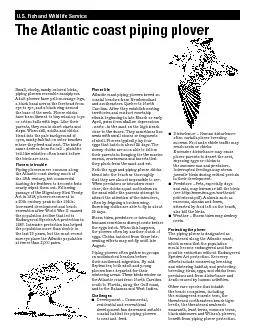/


coastal beaches from Newfoundland and southeastern Quebec to North Carolina After they establish nesting territories and conduct courtship rituals beginning in late March or early April pairs f ID: 139625
Download Pdf The PPT/PDF document "Atlantic coast piping plovers breed on" is the property of its rightful owner. Permission is granted to download and print the materials on this web site for personal, non-commercial use only, and to display it on your personal computer provided you do not modify the materials and that you retain all copyright notices contained in the materials. By downloading content from our website, you accept the terms of this agreement.
Atlantic coast piping plovers breed on coastal beaches from Newfoundland and southeastern Quebec to North Carolina. After they establish nesting territories and conduct courtship rituals beginning in late March or early April, pairs form shallow depressions - nests - in the sand on the high beach close to the dunes. They sometimes line nests with small stones or fragments of shell. Plovers typically lay four eggs that hatch in about 25 days. The downy chicks are soon able to follow their parents in foraging for the marine worms, crustaceans and insects that they pluck from the sand and eat. Both the eggs and piping plover chicks blend into the beach so thoroughly When predators or intruders come close, the chicks squat motionless on the sand while the parents attempt to attract the attention of the intruders, often by feigning a broken wing. Surviving chicks are able to y in about 30 days. Storm tides, predators or intruding humans sometimes disrupt nests before the eggs hatch. When this happens, the plovers often lay another clutch of eggs. Chicks hatched from these late- nesting efforts may not y until late August. Piping plovers often gather in groups on undisturbed beaches before their southward migration. By mid- September, both adult and young plovers have departed for their Human disturbance often curtails plover breeding success. Foot and vehicle traf c may crush nests or chicks. Excessive disturbance may cause plover parents to desert the nest, exposing eggs or chicks to the summer sun and predators. Interrupted feedings may stress juvenile birds during critical periods in their development. Predators -- possible extinction without Endangered Species Act protection. Recovery efforts include conserving breeding and wintering habitat; and protecting breeding birds, eggs, and chicks from predators and from disturbance and death caused by human activities. Other rare species that inhabit the beach ecosystem, including the endangered roseate tern, the threatened northeastern beach tiger beetle, the threatened seabeach amaranth, least terns, common terns, black skimmers and Wilson’s plovers, bene t from piping plover protection. M A R C H 3 , 1 8 4 9 U . S . D E P A R T M E N T O F T H E I N T E R I O R You can help protect piping plovers The Endangered Species Act provides penalties for killing, harassing or harming piping plovers. Respect all areas fenced or posted for protection of wildlife. Do not approach or linger near piping plovers or their nests If pets are permitted on beaches used by plovers, keep your pets leashed. Do not leave or bury trash or scraps of food on beaches -- food attracts plover predators. For more information about Atlantic coast piping plovers, see http://www. fws.gov/northeast/pipingplover. Illustrations by Julie Zickfoose For further information contact: Of ce of Endangered Species U.S. Fish and Wildlife Service 300 Westgate Center Drive Hadley, MA 01035-9587 413/253 8200 Federal Relay Service for the deaf and hard-of-hearing 1 800/877 8339 U.S. Fish & Wildlife Service 1 800/344 WILD http://www.fws.gov August 2007